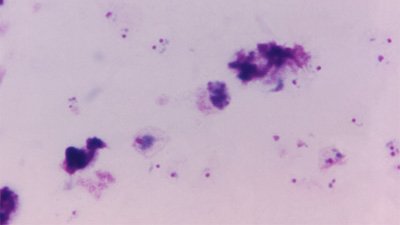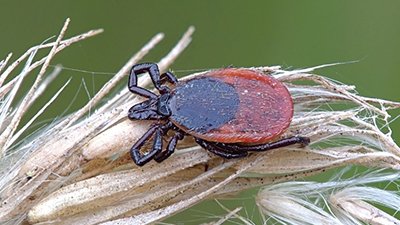
Special Report: West Nile Virus—Will It Strike the States Hard Again?
West Nile virus: brought to you by public enemy number one
News Source
- American Society For Microbiology: “FAQ: West Nile Virus, July 2013”
“West Nile virus is the most significant exotic mosquito-borne disease that has come to the contiguous United States in the last century,” according to Dr. Lyle Peterson of the Centers for Disease Control. “Outbreaks have proven extremely difficult to predict and control and have been associated with considerable morbidity [including death]. The large outbreak in 2012, which caught many by surprise, indicates that West Nile virus will remain a formidable public health challenge for years to come.”
West Nile virus, first diagnosed in Uganda in 1937, only arrived in North America in 1999. Like many immigrants, it started its American adventure in New York City and rapidly progressed across the continent. With outbreaks in California and the western Plains and Rocky Mountain States in 2002, it has since spread to the 48 contiguous United States. The massive outbreak in 2012, which killed 286 in the United States alone,1 showed the disease is here to stay. Will this summer’s heavy rainfall lead to an encore performance? Does this virus constitute an evolving predator of some sort? What should we expect, and how can we protect ourselves?
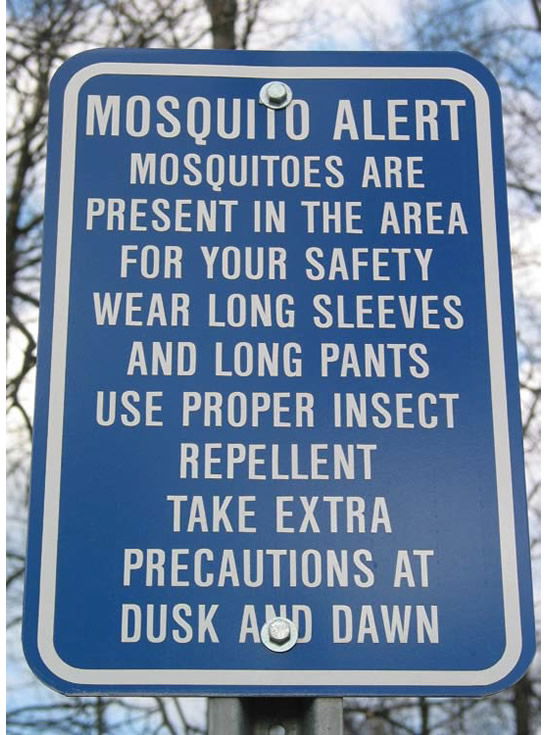
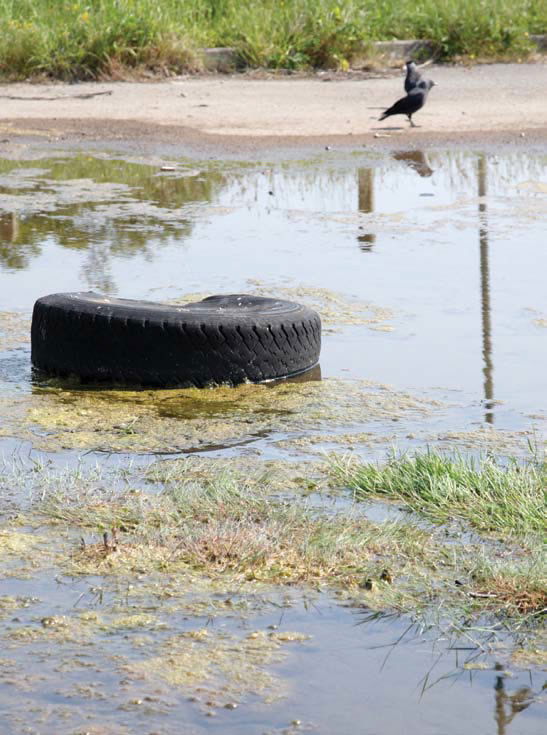
Mosquitoes breeding in standing water can produce many dangerous vectors to carry West Nile virus from its reservoir in birds to humans. Images from American Academy of Microbiology.
How It Causes Disease
West Nile virus—like all viruses—is unable to reproduce without help. Consisting of a small amount of genetic material with just enough protein to keep itself together, a virus infects the cells of its host and co-opts the cellular machinery to replicate itself. West Nile virus is a Flaviviridae virus, a group of viruses carried by arthropods such as mosquitoes.
Just as the malaria-causing parasitic protozoan Plasmodium is carried by Anopheles mosquitoes, so West Nile virus is transmitted to humans and susceptible animals by the bites of infected Culex mosquitoes. Most—but not all—female mosquitoes require a “blood meal” in order to reproduce. (Male mosquitoes and even females of some species still subsist on plant nectar and other plant juices, but the females of most species today consume blood.)2 When a female mosquito bites a targeted human or animal, it injects saliva with anticoagulant properties. If the mosquito is infected with West Nile virus—an infection that causes the mosquito few if any difficulties—then viruses are dumped into the target’s blood.
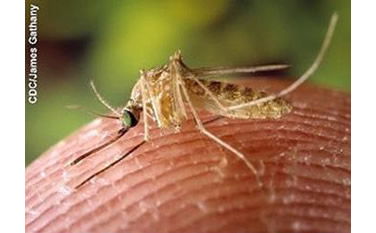
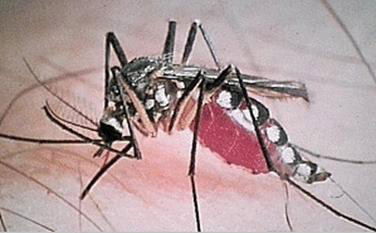
On the left it a typical Culex house mosquito. This sort of mosquito transmits West Nile virus from birds to people. (People cannot catch the infection directly from infected birds.) On the right is a “tree hole” Aedes mosquito, which transmits the heartworms that endanger our pets. In addition to reminding us to protect our pets as well as ourselves from mosquito-borne infections, its nickname is a reminder that we each are responsible to rid our own environs as much as possible of standing water where mosquitoes breed. Images: www.idph.state.il.us
In the case of West Nile virus, only 20 to 25% of infected people develop symptoms. (For this reason, donated blood supplies are screened for West Nile virus to avoid transmitting the infection with transfused blood.) Most of those with symptoms develop a flu-like illness. Life-threatening West Nile neurologic disease—either encephalitis or meningitis—develops in some (less than one percent), however, and a tenth of those patients die. There is no known treatment and no vaccine for human victims.3 So far, no one even knows what risk factors make an infected person more likely to develop symptoms, although as with most infections, the immune-compromised and the elderly are at somewhat greater risk of developing severe disease.
West Nile virus is not normally transmitted from person to person, even with a mosquito’s help. West Nile virus needs to be “amplified” by infecting a bird. Bird susceptibility varies from species to species, but the virus multiples very successfully in infected birds, even producing a billion times the viral population of a mammalian host. Some birds die, but surviving birds become immune after being infectious for only a few days. Mosquitoes that bite infected birds get infected themselves and soon begin transmitting the infection through their saliva.

West Nile virus multiplies vigorously in infected birds, and Culex mosquitoes biting those birds during the early days of their infection can carry the virus to humans and to horses. Image from American Academy of Microbiology.
Of the two known genetic lineages of West Nile virus, only one—the most dangerous one—has appeared in the United States. Although 65 of the 160 mosquito species in the United States are known to carry West Nile virus, only mosquitoes that bite both humans and birds transmit the disease to people. Thus, West Nile virus is transmitted to people by mosquitoes of the Culex genus, such as Culex pipiens, Culex quinquefasciatus, and Culex tarsalis. Because some of these species frequent indoor dwellings, even staying indoors does not prevent infection.
Evolutionary Implications?
The finely tuned relationship between viruses like West Nile virus, their vectors (like mosquitoes), amplifying hosts (like birds), and “dead-end hosts” (like humans, who cannot ordinarily pass the infection to others), is interpreted by evolutionary scientists as a product of millions of years of evolutionary adaptations. For instance, the monograph recently produced by the American Academy of Microbiologists states:
Because viruses are completely dependent on their hosts to replicate, they have evolved a vast arsenal of tricks for getting into host cells, co-opting those cells to make more viruses, and then escaping to infect more cells. Viruses have developed these tricks through millions of years of evolutionary battle with their hosts—the host evolves to avoid the virus and the virus evolves countermeasures to evade host defenses and gain access to its cellular machinery. After so much back and forth, most host-virus interactions are very species specific and indeed, many viruses only infect specific kinds of cells within their hosts. Each virus has evolved a life cycle strategy to overcome its inability to reproduce on its own, and that strategy affects when and where disease outbreaks occur. After figuring out how to invade and replicate in host cells, viruses also have to get from host to host. . . . WNV uses mosquitoes to carry it from bird to bird, birds being the hosts that it uses for amplification within the environment.
From an evolutionary point of view, one must immediately ask why the virus would have established itself in hosts (like humans) that are “evolutionary dead-ends.” Because West Nile virus cannot ordinarily be passed on from humans to other humans, mosquitoes, or any other hosts, adaptation to human hosts offers no evolutionary advantage to the virus. Humans are thus considered a “dead-end” host.4 But if the virus does not gain any reproductive advantage from residing in humans, why retain that host in an evolutionary scheme?
What Do We Observe?
No virus developed into anything other than a virus.
Furthermore, in this scenario described in the monograph, no virus developed into anything other than a virus. In fact, in the case of “Lineage 1 strains” of West Nile virus, the many isolates collected from mosquitoes, birds, and humans in the United States are “almost identical genetically.” The authors of the monograph (which is extremely informative and interesting, incidentally) note that viruses with such complex life cycles do not tend to mutate often because “a mutation that helps the virus in one host might limit its replication in another.” Yet if dead-end hosts are of no advantage, one might well ask why they haven’t been excluded by a random mutation.
West Nile virus in the United States has, researchers think, undergone a couple of significant mutations. One of these mutations increases the virulence in crows, causing many to die. In fact, public health officials trying to assess the prevalence of West Nile virus have done much of their work by testing the birds found dead. But of what evolutionary advantage is a mutation that causes the death of its hosts?
A more pertinent point, however, is the fact that none of the viruses in this evolutionary interpretation of viral history mutate into non-viruses. They never acquire the genetic information to become free-living organisms. In fact, in the case of West Nile virus, the viral genome only encodes 10 proteins. If the brilliant virus described above really did have to “figure out” how to move from host to host and so forth, one might well wonder how it managed to acquire all the genetic information to perform these wonders through random processes and still only have 10 proteins produced by the scant 11,000 nucleotides in its genome. As an alternative explanation creationist microbiologists point to the evident design in such viruses and note how natural selection and other genetic mechanisms have influenced adaptation with a complex life cycle over the past few thousand years.
Moreover, mosquitoes remain mosquitoes, birds remain birds, and people remain people. The processes of adaptation through natural selection and other modes of genetic shuffling of mutations and variations do not produce the sort of genetic changes that are required to evolve increasingly complex organisms. They only produce variations within each kind of organism or virus. This is not an example of molecules-to-man evolution. It is however a good illustration of how the original “very good” world God created has gone wrong. After man sinned and sin’s curse entered this perfect world (Romans 8:18–25), some microbes apparently became pathogenic through adaptation to a harsh cursed world. This view fits with observable biology.
Why Do We Even Have These Scourges?
West Nile virus, and most viruses for that matter, have not yet been studied long enough to uncover all the probable roles they likely played in a very good creation. Yet many clues are emerging, and the popular view that viruses are merely the agents of disease is both oversimplified and incorrect. Like bacteria and other microbes, viruses seem to fill vital roles in many organisms and ecosystems. Biologist Dr. Joseph Francis of The Master’s College in Santa Clara, California, proposes that microbes and viruses may have been “created as a link between macro-organisms [like plants, animals, and people] and a chemically rich but inert physical environment.”5
And some oncolytic viruses are now being examined for their ability to attack cancer cells, suggesting a possible homeostatic and regulatory role in their original purpose6 Alan Gillen and Frank J. Sherwin III, in a recent AiD paper, suggested: “In a pre-Fall world devoid of disease, the immune system could have regulated the normal human microbiome and been involved in the recycling of old cells.” Other research has recently shown that viruses in mucus may play a vital protective role in humans and all sorts of animals.
And what of mosquitoes? Mosquitoes are the vectors for viral encephalitis, yellow fever, dengue fever, elephantiasis (lymphatic filariasis), and, as discussed recently, for malarial protozoans. An Illinois Department of Public Health bulletin on mosquito-borne disease summarizes, “What’s the most dangerous creature on earth? Without question the answer is: the mosquito. Mosquitoes and the diseases they spread have been responsible for killing more people than all the wars in history.”7
Have mosquitoes always been the scourge of mankind? God our Creator knows all things, including the condition of the world as He originally created it, and He assures us the world He made was “very good” (Genesis 1:31). Therefore, mosquitoes in the original creation must have been harmless to people and animals. They likely were simply pollinators. Today they still pollinate certain grasses, orchids, and goldenrod. The fact that today male mosquitoes and even the females of some species subsist on plant juices and nectar without consuming blood points to a pollinator role at a time before mosquitoes became public enemy number one.
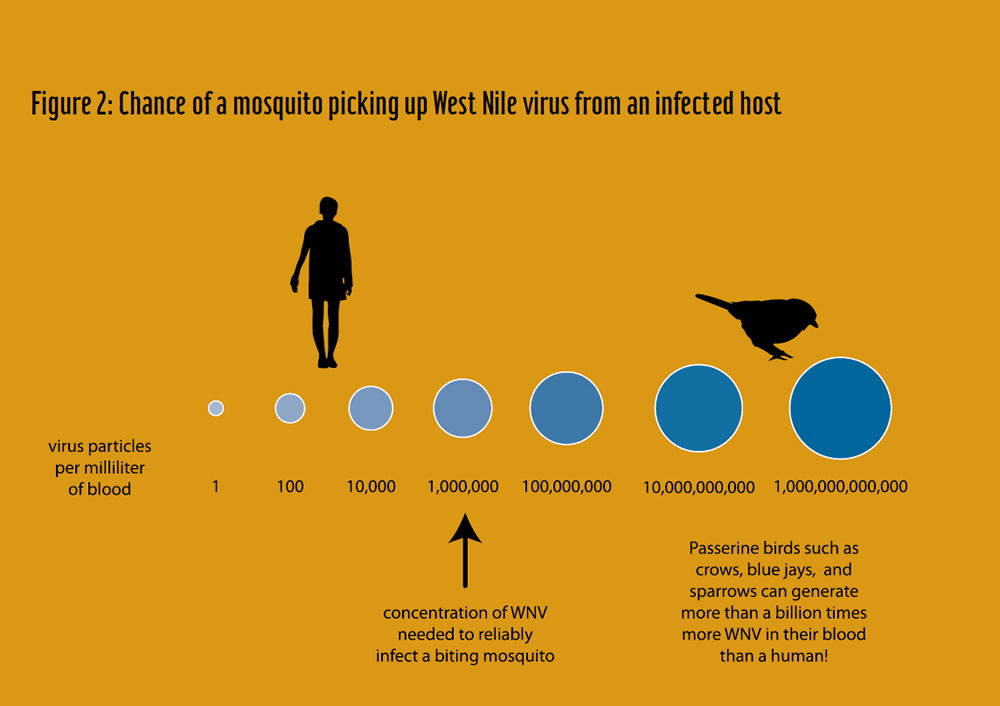
Because West Nile virus does not multiply as successfully in humans or horses as in birds, mosquitoes do not ordinarily ingest a sufficient quantity of virus to get infected when they bite infected people or horses. Many birds are “amplifying reservoirs” during their infectious period, however, and Culex mosquitoes biting them get infected and become infectious. Image from American Academy of Microbiology.
What Can We Do?
Now that many mosquitoes have become agents of disease and death, is there anything we can do to protect ourselves against West Nile virus? Vaccines will not likely be developed and would not be a cost effective use of medical resources. The birds in places where there have been recent outbreaks are generally immune to the virus, affording only a temporary lowering of risk, as their offspring are not. High precipitation and warm weather are thought to increase the risk of outbreaks. Warm winters probably also increase the risk. Public health officials in many areas have stopped screening for the virus and turned to mosquito control as a more cost-effective measure.
The burden of protection is largely an individual matter. Public health officials point out that while some sources of water for mosquito breeding are difficult to eradicate, property owners can eliminate many. Culex mosquitoes do not typically venture far from where they develop as larvae.8 Typically water that stands for a week becomes a breeding ground for these dangerous pests, so a simple precaution available to us all is to be certain the bird baths, wading pools, tree holes, ditches, flower pots, clogged gutters, old tires, etc.—are drained or emptied of standing water every few days.9 Public health officials recommend diligent use of window screens and mosquito repellents, especially in the warmer seasons, with additional precautions such as long sleeves and long pants for people out at dusk and after dark. (See the CDC website for more information.)
Meanwhile, as we ponder the catastrophic effects of man’s rebellion on God’s good creation, we are reminded of the effects of sin on our own souls (Romans 3:23; 6:23). And while we must battle the effects of sin’s curse (Romans 8:18–25) on the earth and our bodies, we can be thankful that Jesus Christ has already fought (2 Corinthians 5:21; Hebrews 2:9–10) and won the battle (Romans 5:8–12; 1 Corinthians 15:26; 1 John 3:8) for our eternal salvation.
Further Reading
- Virus “Evolution” Benefits Mankind?
- The Genesis of Malaria
- “Partners in Slime”: Mucus and Our Viral Friends
- Did God Make Pathogenic Viruses?
- This information is intended for general education purposes only and is not intended as professional medical advice. The information should not be relied upon as a substitute for medical advice from your doctor or other healthcare professional. If you have specific questions about any medical condition, diagnosis, or treatment, you should consult your doctor or other healthcare provider.
For More Information: Get Answers
Remember, if you see a news story that might merit some attention, let us know about it! (Note: if the story originates from the Associated Press, FOX News, MSNBC, the New York Times, or another major national media outlet, we will most likely have already heard about it.) And thanks to all of our readers who have submitted great news tips to us. If you didn’t catch all the latest News to Know, why not take a look to see what you’ve missed?
(Please note that links will take you directly to the source. Answers in Genesis is not responsible for content on the websites to which we refer. For more information, please see our Privacy Policy.)
Footnotes
- University of British Columbia, “Bird Vaccine for West Nile Virus,” ScienceDaily, July 9, 2013, www.sciencedaily.com/releases/2013/07/130709094836.htm.
- “Mosquitoes and Disease,” Illinois Department of Public Health, http://www.idph.state.il.us/envhealth/pcmosquitoes.htm.
- A vaccine is under development for birds in hopes of protecting endangered species and reducing the viral reservoir in birds; see Joanne A. Young and Wilred Jefferies, “Towards the Conservation of Endangered Avian Species: A Recombinant West Nile Virus Vaccine Results in Increased Humoral and Cellular Immune Responses in Japanese Quail (Coturnix japonica),” PLoS ONE, June 25, 2013, doi:10.1371/journal.pone.0067137.
- “Mosquitoes and Disease.”
- Joe Francis, “The Organosubstrate of Life: A Creationist Perspective of Microbes and Viruses,” Answers in Depth 4 (May 20, 2009), https://answersingenesis.org/biology/microbiology/the-organosubstrate-of-life/.
- Luke Kim, “Viral/Bacterial Attenuation and Its Link to Innate Oncolytic Potential: Implications of the Perfect Original Creation in the Beginning” in “Proceedings of the Microbe Forum, June 2007,” Answers Research Journal 1 (January 9, 2008), https://answersingenesis.org/biology/microbiology/proceedings-of-the-microbe-forum-june-2007/.
- “Mosquitoes and Disease.”
- Ibid.
- Ibid.
Recommended Resources

Answers in Genesis is an apologetics ministry, dedicated to helping Christians defend their faith and proclaim the good news of Jesus Christ.
- Customer Service 800.778.3390
- © 2024 Answers in Genesis


